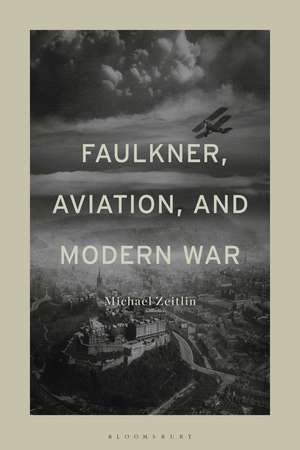Faulkner, Aviation, and Modern War
Autor Dr. Michael Zeitlinen Limba Engleză Paperback – 26 iul 2023
| Toate formatele și edițiile | Preț | Express |
|---|---|---|
| Paperback (1) | 191.31 lei 6-8 săpt. | |
| Bloomsbury Publishing – 26 iul 2023 | 191.31 lei 6-8 săpt. | |
| Hardback (1) | 568.80 lei 6-8 săpt. | |
| Bloomsbury Publishing – 12 ian 2022 | 568.80 lei 6-8 săpt. |
Preț: 191.31 lei
Preț vechi: 249.34 lei
-23% Nou
Puncte Express: 287
Preț estimativ în valută:
36.61€ • 39.75$ • 30.75£
36.61€ • 39.75$ • 30.75£
Carte tipărită la comandă
Livrare economică 22 aprilie-06 mai
Preluare comenzi: 021 569.72.76
Specificații
ISBN-13: 9781501376054
ISBN-10: 1501376055
Pagini: 248
Ilustrații: 10 bw illus
Dimensiuni: 152 x 229 x 25 mm
Greutate: 0.34 kg
Editura: Bloomsbury Publishing
Colecția Bloomsbury Academic
Locul publicării:New York, United States
ISBN-10: 1501376055
Pagini: 248
Ilustrații: 10 bw illus
Dimensiuni: 152 x 229 x 25 mm
Greutate: 0.34 kg
Editura: Bloomsbury Publishing
Colecția Bloomsbury Academic
Locul publicării:New York, United States
Caracteristici
By focusing on planes as symbols of military-industrial technology and modernity, this book traces Faulkner's evolution as a writer through the pre- and post-war periods of the 20th century
Notă biografică
Michael Zeitlin is Professor of English at the University of British Columbia, Canada. He is the editor of Misrecognition, Race, and the Real in Faulkner's Fiction (2004) and former co-editor of The Faulkner Journal.
Cuprins
List of FiguresPrefaceAcknowledgmentsAbbreviations1. The Original Accident2. New Haven, Spring 1918: The War and the Newspapers3. Transfiguration: Chapman, Guynemer, Lufbery 4. Faulkner and the Royal Air Force5. The Embryo Pilot 6. Wounded Flyer7. "Love," Manservant, and Faulkner's First Screenplay8. Pylon: The Last War and the NextCoda: Faulkner and Jimmy McCudden at the Savoy: A FableWorks CitedIndex
Recenzii
Michael Zeitlin has written a book that will change the way Faulkner scholars understand the author's life-long obsession with airplanes, pilots, and flying. An astonishing amount of research into World War I aviation is skillfully woven together to provide a rich context for understanding Faulkner's novels and short stories as part of Faulkner's life and times in important new ways.
Stunning insight, beautifully written. Zeitlin's work changes the meaning of perspective in Faulkner's vision: his ways of seeing. Engaging modernity in Modernism, Faulkner, Aviation and Modern War speaks to a waiting audience about flight itself to capture meaning through this incisive turn in Euro-western mythos and masculinity.
William Faulkner's idolatry of the aeroplane, and of the crazy bold pilots who cut the skies to ribbons with one in the 1920s and 30s, is one of those happy freaks of literary modernism that seemed never to achieve its critical reckoning. Well, here it is. Michael Zeitlin's exhaustive research has deftly negotiated all the pylons, and in his high-octane thrill-ride alongside military aviators, barnstormers, commercial aces and all the dead pilots, we glimpse an aerial map of Faulkner's stylistic physiognomy. That quixotic desire to lift his poly-clausal periods above the turbulence of ideological conflict and draw in the gravid air his stately figures of torque made Faulkner's flyboy dreaming into art. With this book, Zeitlin has plotted the great author's death-drag dromology as the weightless career of a Sopwith Camel along the border between myth and metal.
Michael Zeitlin's new book is a singular achievement. He is the first Faulkner scholar to take on the whole of the author's flying corpus, and Zeitlin shrewdly analyzes the role of aviation, and, in particular, wartime flight in Faulkner's writing and thought...All of this comes to us in a prose as graceful as those pilots' soaring and dipping as well as through a writerly voice as unassuming and assured as that of men like Chapman, George Guynemar, and Raoul Lufbery were in flight.
Stunning insight, beautifully written. Zeitlin's work changes the meaning of perspective in Faulkner's vision: his ways of seeing. Engaging modernity in Modernism, Faulkner, Aviation and Modern War speaks to a waiting audience about flight itself to capture meaning through this incisive turn in Euro-western mythos and masculinity.
William Faulkner's idolatry of the aeroplane, and of the crazy bold pilots who cut the skies to ribbons with one in the 1920s and 30s, is one of those happy freaks of literary modernism that seemed never to achieve its critical reckoning. Well, here it is. Michael Zeitlin's exhaustive research has deftly negotiated all the pylons, and in his high-octane thrill-ride alongside military aviators, barnstormers, commercial aces and all the dead pilots, we glimpse an aerial map of Faulkner's stylistic physiognomy. That quixotic desire to lift his poly-clausal periods above the turbulence of ideological conflict and draw in the gravid air his stately figures of torque made Faulkner's flyboy dreaming into art. With this book, Zeitlin has plotted the great author's death-drag dromology as the weightless career of a Sopwith Camel along the border between myth and metal.
Michael Zeitlin's new book is a singular achievement. He is the first Faulkner scholar to take on the whole of the author's flying corpus, and Zeitlin shrewdly analyzes the role of aviation, and, in particular, wartime flight in Faulkner's writing and thought...All of this comes to us in a prose as graceful as those pilots' soaring and dipping as well as through a writerly voice as unassuming and assured as that of men like Chapman, George Guynemar, and Raoul Lufbery were in flight.
